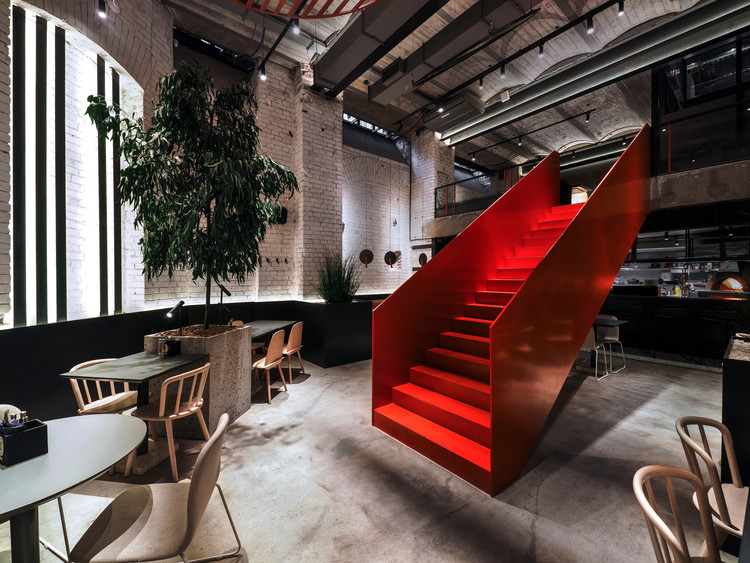Villa Città Studi Westway Architects
2016-12-17 05:00
© Andrés Otero/LUZphoto
c Andrés Otero/LUZ照片


架构师提供的文本描述。从外部看,它看起来像是1920年至1924年期间在米兰为铁路工人建造的典型住房之一。在内部,这座建筑进行了彻底的改造,经过两年的建设,它从结构和分布的角度都发生了变化。只有相对开口的建筑围护结构得到了维护,而其他一切-地基、屋顶、阁楼、内部绝缘、系统和内部分配-都是从零开始创建的。由于楼板、楼梯和阁楼的复垦,总体积保持不变,而楼面面积则增加了60平方米。
Text description provided by the architects. From the outside, it looks like one of the typical housing blocks built for railway workers in Milan between 1920 and 1924. Inside, the building has undergone radical renovation which, in two years of construction, has transformed it from both a structural and distribution point of view. Only the building enclosure, with its relative openings, has been maintained, while everything else — foundations, roof, attics, internal insulation, systems, and internal distribution — has been created from scratch. The total volume has remained the same, while the floor area has been increased by 60 m2, thanks to the new placement of the floor slabs, staircases and reclamation of the attic.
© Andrés Otero/LUZphoto
c Andrés Otero/LUZ照片


从社会住房到有私人花园的城市别墅,位于米兰CittàStudi区的一个20世纪20年代的村庄。从一个大的家庭住宅到一个单身公寓,重新设计以满足他的特殊需求,使用先进的家庭自动化系统,并按照B级CENED能源认证标准。
From social housing to a city villa with private garden, in a 1920s village in the Città Studi district of Milan. From a large family residence to a bachelor pad, redesigned to meet his specific needs, using a sophisticated home automation system, and according to Class B CENED energy certification standards.


“作为建筑师,住宅的垂直形式给了我们机会,使我们的梦想成为现实:埃舍尔不可能建造的楼梯系统之一。”客户让自己被这个梦想迷住了!我们清空了内部,这样空间就可以水平地和垂直地扩展,我们创造了一个结构自主的中央核心,与现有的历史背景隔绝。这延伸到五层楼,每一层都有两个独立的楼梯,沿着纵向承重墙“,卢卡·奥雷吉解释道。单层楼梯很窄(80厘米),可以从地下室连接到四楼(健身区、餐饮和厨房区、客厅、卧室、书房)-不是连续的,而是交替的。这是一条弯弯曲曲的路线,涉及到各个楼层的交叉,这些楼层没有隔间(开放空间)。“住宅设计为垂直阁楼特色的强制性路线,在那里迷路和发现自己成为一项游戏。由此产生的困惑感放大了对空间的感知“。L.A.
“The vertical form of the dwelling gave us the chance to make one of our dreams as architects come true: one of the staircase systems of Escher's impossible constructions. The client allowed himself to be captivated by this dream! We emptied the interior so that the space could be expanded horizontally and vertically and we created a structurally autonomous central core cut off from the existing historical context. This stretches over the five floors, each one served by two separate staircases positioned along the longitudinal load-bearing walls”, explains Luca Aureggi. The single-flight staircases are narrow (80 cm) and enable a connection from the cellar to the fourth floor (fitness area, dining and kitchen area, living room, bedroom, study) — not continuously, but alternately. It's a zig-zag route involving the crossing of the individual floors, which are devoid of partitions (open space). “The home is designed as a vertical loft featuring a mandatory route, where getting lost and finding oneself becomes a game. The resulting sense of bewilderment magnifies the perception of the space”. L.A.
© Andrés Otero/LUZphoto
c Andrés Otero/LUZ照片


所有的材料都有助于创造一个流动的空间,一直延伸到露台和花园。与户外的关系受到这些绿色投影的青睐,这些绿色投影将建筑周围的“乡村”现实联系在一起,这对于一个大城市来说是非常不典型的。这就像发现自己置身于巴勒莫(Palermo)-业主的家乡-的决斗之中。
All the materials used contribute to creating a fluid space stretching all the way to the terrace and garden. The relationship with the outdoors is favoured by these green projections that contextualize the building within the convivial “rustic” reality surrounding it, which is very atypical for a big city. It's like finding oneself inside a hortus conclusus with a vibe of Palermo — the owner's hometown.
© Andrés Otero/LUZphoto
c Andrés Otero/LUZ照片


从前门,你会发现自己跳进了俯瞰花园的餐厅和厨房的长远视野中。这是一个垂直上升的开始,通过各种楼梯挤压在纵向承重墙和中央核心结构之间。飞机的小尺寸是由着陆的宽度来平衡的-一个人必须通过地面的一部分才能进入随后的楼梯飞行。上升的过程一直持续到以前的阁楼所创造的研究区域。没有什么阻碍向上奔跑或下降到健身区。少数几件家具大多是老式家具,高度有限,没有门或衣柜。楼层和楼梯构成一个单一的结构和材料实体,所有的都在同一木板条。然而,许多定制细节,特别材料和成品的选择,以及不断扩大空间的三维空间,使这200平方米的房子伟大。
From the front door, one finds himself catapulted into the long perspective of the dining and kitchen area that overlooks the garden. This is the beginning of a vertical ascent via the various staircases squeezed between the longitudinal load-bearing walls and the central core structure. The small size of the flights is balanced by the width of the landing — a part of the floor one must pass through to access the subsequent flight of stairs. The ascent continues all the way to the study area created in what was formerly the attic. Nothing hinders an upwards run or descent towards the fitness area. The few pieces of mostly vintage furniture are limited in height and there are no doors or wardrobes. Floors and staircases form a single structural and material entity, all clad in the same wooden slats. It is, however, the many custom details, the choice of ad hoc materials and finishes, and the continuous quest to broaden the space in 3D that makes this 200-square-metre house great.
© Andrés Otero/LUZphoto
c Andrés Otero/LUZ照片










































































Architects Westway Architects
Location Milan, Italy
Category Renovation
Area 168.0 m2
Project Year 2013
Photographs Andrés Otero/LUZphoto
Manufacturers Loading...































